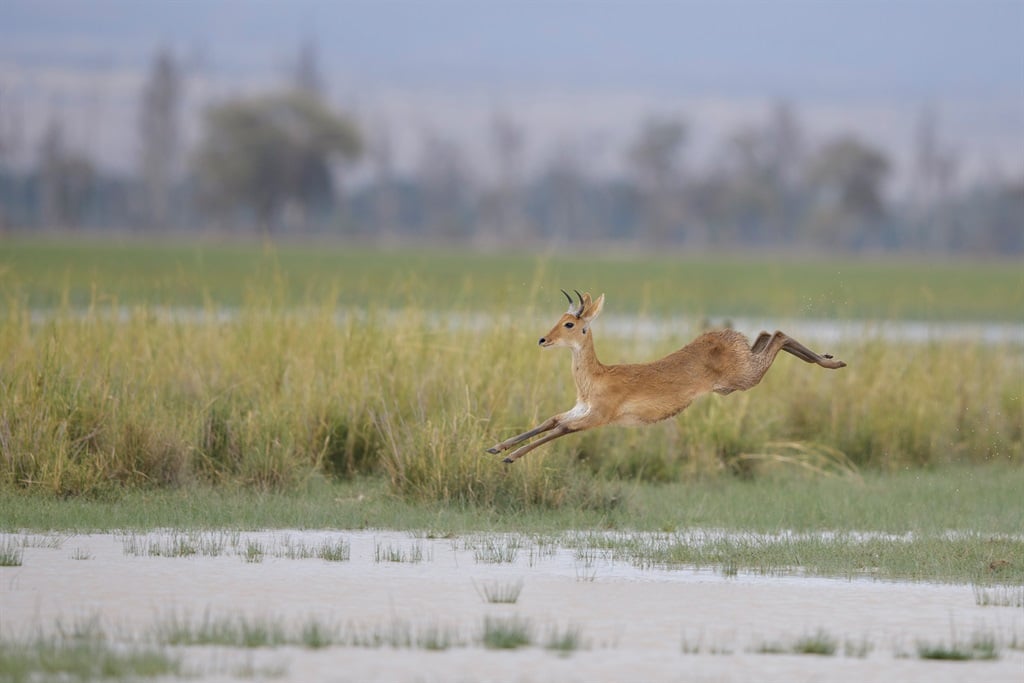
- A new aerial survey has shown that South Sudan is home to the largest land mammal migration on earth – some 6 million antelope.
- The migration, referred to as the Great Nile Migration, was documented in
the survey of the Boma Badingilo Jonglei Landscape. - A senior UN official says the discovery is a chance for “the country to
embark on a new narrative that is not just conflict and poverty”. The private sector has also been called on to invest in tourism ventures. - For more financial news, go to the News24 Business front page.
South Sudan’s first comprehensive aerial wildlife survey has revealed that
the Eastern African nation hosts the largest land mammal migration on Earth,
involving approximately six million antelope, according to those involved in
the survey.
The migration, referred to as the Great Nile Migration, was documented in
the survey of the Boma Badingilo Jonglei Landscape (BBJL). This achievement is
the result of a partnership between the government of South Sudan and nonprofit
conservation groups, African Parks and the Wilderness Project.
According to Africa Parks, “each year, millions of white-eared kob,
Mongalla gazelle, tiang and reedbuck migrate across the BBJL”.
The documentation of the Nile migration highlights South Sudan’s ecological
and conservation relevance, potentially reshaping the image of Africa’s
youngest nation, which has faced ongoing civil unrest since 2013 – and acting
as a magnet for tourists.
According to Nicholas Haysom, the Head of the United Nations Peacekeeping
Mission, UNMISS, “this announcement is an opportunity for the country to
embark on a new narrative that is not just conflict and poverty”.
“This is a national asset and a gift, one which provides a source of
unity and pride for the people of South Sudan at a time when the country is
otherwise battling food insecurity, economic hardship, flooding, and the impact
of conflict in Sudan,” he explained.
South Sudan has a long history of civil unrest that has continued to
negatively influence conservation efforts. The Conflict Sensitivity Resource
Facility (CSRF), a peace advocacy group, reports that after the 2005
Comprehensive Peace Agreement, only two international conservation
organizations, the Wildlife Conservation Society (WCS) and Fauna & Flora,
resumed work in South Sudan.
More than a decade later, ongoing internal conflicts continue to hinder
investment in Protected Areas (PAs), considering the intense civil that has
continued since 2013. Failed peace talks reignited conflict in 2016, escalating
ethnic tensions between the Dinka and Nuer tribes.
The recent survey is countering this negative trend that threatens
conservation by uncovering the extensive species in the country while rallying
the government and conservation groups to ramp up strategic conservation
efforts.
The survey covered a 122,774 km2 contiguous block, encompassing the entire
known range of the four main migratory antelope species in the Great Nile
Migration. Data from 251 tracking collars placed on large mammals was also
integrated into the assessment, providing a holistic understanding of the
region’s ecological dynamics which continues across the boundary of South
Sudan, into Gambella National Park in Ethiopia.
“The findings confirm a remarkable and unmatched wildlife phenomenon
across a landscape of immense ecological importance,” Africa Parks
explained in a statement on June 25.
According to Peter Fearnhead, CEO of African Parks, “The results of
this survey are nothing short of staggering.”
“The astonishing scale of the migration is only equalled by the
responsibility to ensure that it survives into the future in an extremely
complex landscape,” he explained.
Many ethnic groups live within the BBJL ecosystem, including the Dinka,
Murle, Anyuak, Jie, Toposa, Nyangatom, Nuer, Mudari, Bari, Lokyoya, Madi,
Lolubo, Ari, Lopit, Latuka, Boya, and Didinga.
“Each of these communities has deep cultural traditions, and livelihood
activities that are firmly embedded and heavily reliant on wildlife and the
vast landscapes they inhabit,” Africa Parks explained.
However, with the discovery comes an increased commitment to reinforce
conservation efforts in not only the ecosystem but also across the country’s
conservation areas.
President Salva Kiir Mayardit of South Sudan, while announcing the survey
results, committed government support through the Ministry of Wildlife and its
partners. He emphasised prioritising the training and equipping of wildlife
rangers to combat poaching and wildlife trafficking:
I also urge the private sector to embrace this exciting opportunity and invest in wildlife tourism ventures. Protecting our heritage is a shared responsibility.
Beyond South Sudan, more African countries are ramping up wildlife surveys
to assess populations and bolster conservation efforts. Meanwhile, conservation
NGOs and private sector players are investing heavily in this promising
industry through government partnerships.
In April, Elephants Without Borders published an analysis comparing Africa’s
two largest aerial elephant surveys. These surveys covered the Kavango Zambezi
Transfrontier Conservation Area, home to over half the world’s savanna
elephants.
The KAZA stretches some 520 000 square kilometres across Angola, Botswana,
Namibia, Zambia, and Zimbabwe. The surveys confirmed stability in the
population of elephants in this ecosystem.
Notably, technology is transforming wildlife surveys in Africa, moving
researchers away from the traditional oblique-camera-count (OCC) approach
toward more effective and accurate methods.
A June 2024 report highlights using a semi-automated deep learning (SADL)
model at Comoé National Park in Ivory Coast. This model successfully estimates
wildlife populations, including small species previously difficult to count,
achieving a 98% time-saving.
“Will AI revolutionise wildlife aerial surveys? Our results suggest
that we are heading in this direction. The significant time saving compared to
fully manual image interpretation is a major step toward revolutionizing aerial
surveys in Africa,” the researchers explain in the report published in the
Ecological Informatics Journal.




Recent Comments